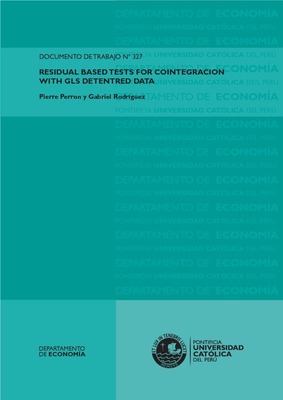| dc.contributor.author | Perron, Pierre | |
| dc.contributor.author | Rodríguez, Gabriel | |
| dc.date.accessioned | 2015-03-19T20:37:53Z | |
| dc.date.available | 2015-03-19T20:37:53Z | |
| dc.date.issued | 2012 | |
| dc.identifier.uri | http://repositorio.pucp.edu.pe/index/handle/123456789/46968 | |
| dc.description.abstract | Este documento analiza diferentes estadísticos basados en los residuos para la hipótesis nula de no cointegración utilizando MCG para eliminar los componentes determinísticos. Las distribuciones asintóticas son simuladas para los casos donde un intercepto y un intercepto y una tendencia son incluidos en la ecuación de cointegración. Los resultados muestran que las distribuciones asintóticas dependen del número de regresores (variables xt), el número y clase de componentes determinísticos y un parámtro de nuisamce R2 que mide la correlación de largo plazo entre los regresores xt y la variable yt. Los resultados muestran que MCG permiten obtener más potencia que el uso de MCO. Esto es más claro para valores de R2 menores que 0:4 y un solo regresor xt. Para valores mayores de R2 los denominados estadísticos ECR son mejores para cualquier número de regresores. En particular el estadístico ECR basado en un vector de cointegración conocido es el más potente. Se presenta una Tabla con valores críticos asintóticos simulados utilizando diferente parámetro c de acuerdo al número de regresores y al tipo de componentes determinísticos. Se eligió R2 = 0:4 por ser un valor sensible en términos prácticos y posiblemente empíricos. | es_ES |
| dc.description.abstract | We analyze di¤erent residual-based tests for the null of no cointegration using GLS detrended data. We find and simulate the limiting distributions of these statistics when GLS demeaned and GLS detrended data are used. The distributions depend of the number of right-hand side variables, the type of deterministic components used in the cointegration equation, and a nuisance parameter R2 which measures the long-run correlation between xt and yt. We present an extensive number of Figures which show the asymptotic power functions of the different statistics analyzed in this paper. The results show that GLS allows obtaining more asymptotic power in comparison with OLS detrending. The more simple residual-based tests (as the ADF) shows power gains for small values of R2 and for only one right-hand side variable. This evidence is valid for R2 less than 0.4. Figures show that when R2 is larger, the ECR statistics are better for any value of the right-hand side variables. In particular, evidence shows that the ECR statistic which assumes a known cointegration vector is the most powerful. A set of simulated asymptotic critical values are also presented. Unlike other references, in the present framework we use different c for different number of right-hand side variables (xt variables) and according to the set of deterministic components. In this selection, we use a R2 = 0:4, which appears to be a sensible choice. | en_US |
| dc.language.iso | spa | es_ES |
| dc.publisher | Pontificia Universidad Católica del Perú. Departamento de Economía | es_ES |
| dc.relation.ispartof | urn:issn:2079-8466 | |
| dc.relation.ispartof | urn:issn:2079-8474 | |
| dc.relation.ispartofseries | Documento de Trabajo;327 | es_ES |
| dc.rights | info:eu-repo/semantics/openAccess | es_ES |
| dc.rights.uri | http://creativecommons.org/licenses/by-nc-nd/2.5/pe/ | * |
| dc.title | Residual Based Test for Cointegration with GLS Detrented Data | es_ES |
| dc.title.alternative | Tests de Cointegración basados en los Residuos utilizando MCG para eliminar los Componentes Determinísticos | es_ES |
| dc.type | info:eu-repo/semantics/workingPaper | |
| dc.type.other | Documento de trabajo | |
| dc.subject.ocde | http://purl.org/pe-repo/ocde/ford#5.02.00 | |
| dc.publisher.country | PE | |
| renati.advisor.orcid | https://orcid.org/0000-0003-1174-9642 | |


